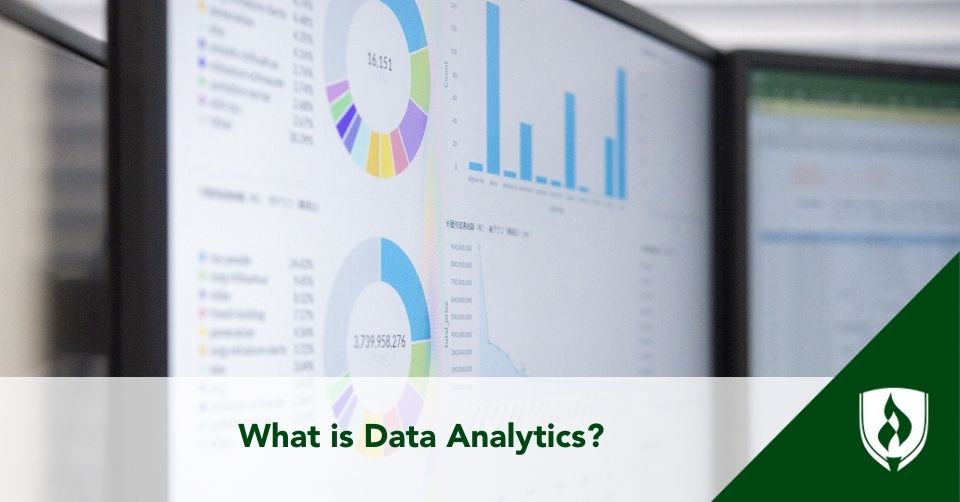What Is Data Analytics?
05/01/2025

Organizations today generate and collect massive amounts of data daily. To make sense of this raw information, many turn to data analytics — a method for drawing actionable insights from large datasets.
Data analytics is the process of examining large datasets to draw meaningful, actionable insights1 that can help organizations improve decision-making, optimize processes, and predict future trends. By transforming raw data into useful insights, businesses can unlock different possibilities.
The Importance of Data Analytics
Data analytics is crucial in today's business world.2 It helps organizations analyze data and identify trends that shape their strategies. Businesses can use both historical and customer data to gain actionable insights. These insights help predict trends, improve operations, and drive informed decision-making. Without data analytics, making sense of the vast amount of data generated daily would be nearly impossible.
Types of Data Analytics
Understanding the different types of data analytics1 can be helpful for understanding the scope of the field.
- Descriptive Analytics: Involves looking at past data to understand what has happened. Through data mining and aggregation, this approach uses statistical analysis to summarize data and identify trends.
- Diagnostic Analytics: Focuses on the “why” behind data trends. By exploring relationships and identifying anomalies, data analysts can uncover causes and correlations within datasets.
- Predictive Analytics: Uses historical data and statistical models to predict what might happen in the future. This may be useful for forecasting future trends and behaviors based on previous patterns.
- Prescriptive Analytics: Provides recommendations for the best course of action. It uses predictive models to optimize operations and advise businesses on how to take advantage of predicted outcomes.
The Data Analytics Process: Steps for Effective Analysis
The data analysis process1 typically follows a series of steps to ensure that the collected data is useful for drawing conclusions and making decisions. This process includes data collection, data cleaning, and data analysis.
1. Data Collection and Cleaning
Data analysts begin by collecting data from various sources. This data could be structured or unstructured and can come from data systems, customer data, or even big data sources. Once collected, analysts must clean the data by removing duplicates, handling missing values, and fixing any inconsistencies in the dataset.
2. Analyzing Raw Data
Once the data is clean, the next step is analyzing raw data to identify trends and patterns. Statistical data analysis plays a critical role at this stage, as analysts use statistical programming languages like R®, Python®, and SQL® to apply data analytics techniques. Common methods include regression analysis, data modeling, and exploratory data analysis (EDA) to extract meaningful insights.
3. Data Visualization and Interpretation
After analysis, it’s important to communicate the findings clearly to stakeholders who make the decisions. Data analysts use data visualization tools like Tableau® or Power BI® to create visual representations of the data. These visualizations may help businesses understand data insights and enable efficient data processing. This stage facilitates clear decision-making and can inform data strategy.
The Benefits of Data Analytics in Business
In a competitive landscape, data analytics can help inform and support a business's decision-making and strategy. By leveraging analytics and automated data analytics, organizations may be on the path to achieving several benefits:
Customer Insight and Marketing Campaigns
Data analytics is invaluable in understanding customer satisfaction and optimizing marketing strategies. By analyzing customer data and behaviors, businesses can tailor marketing campaigns to meet customer preferences with an aim to improve conversion rates.
Operational Efficiency and Product Development
Data analytics may help businesses streamline their operations and reduce costs. For example, efficient supply chain management and predictive maintenance schedules may ensure that resources are used optimally, improving operational efficiency.
Big Data Analytics and Business Intelligence
Big data can provide businesses with vast amounts of relevant information that can be analyzed to improve decision-making. By incorporating business intelligence tools and data science strategies, companies can uncover insights that might otherwise go unnoticed.
Skills and Tools for Data Analytics
Becoming a data analyst requires a combination of technical and soft skills3. Some of the most important data analytics tools include:
- SQL®
- R®
- Python®
- SAS®
In addition to proficiency with these programming languages, it may be useful for data analysts to have skills in:
- Statistical data analysis
- Data mining
- Data visualization techniques
Data analysts must also have a strong understanding of data management practices, which include:
- Ensuring data security
- Protecting sensitive data
Career Paths in Data Analytics
The field of data analytics offers many career opportunities. Professionals in this field, including data scientists and data analysts, play an essential role in helping businesses navigate complex datasets. Some common career paths4 in data analytics include:
- Data Analyst5: Gathers, processes, and interprets large datasets to uncover trends and insights that support business decision-making.
- Business Intelligence Developer: Designs and develops data systems, reports, and dashboards to transform raw data into actionable business insights.
- Systems Engineer: Responsible for designing, implementing, and maintaining an organization’s IT infrastructure and ensuring the smooth integration of hardware and software systems.
- Systems Software Developer:Creates and maintains software applications that interact directly with hardware and operating systems, ensuring efficient performance and functionality.
- Web Analytics Analyst: Analyzes data from websites and digital platforms to optimize user experience, track key performance indicators, and inform digital marketing strategies.
Real-World Applications of Data Analytics
Data analytics is applied across many industries, including healthcare, retail, and entertainment.
Healthcare
Data analytics is used for predictive modeling in disease diagnosis, improving patient care, and streamlining hospital operations. For example, predictive analytics can forecast outbreaks of diseases like the flu6, while data mining techniques are used to identify patterns in patient histories that improve treatment outcomes.
Predictive Analytics in Finance
Predictive analytics is applied to anticipate market fluctuations and assess credit risk. A paper on AI in credit scoring7 examines the various AI models, predictive analytics, and the transition from traditional rule-based systems to AI-driven approaches.
It also discusses the ethical implications, including transparency, fairness, and the role of alternative data, highlighting AI's impact on financial inclusion and decision-making processes.
Retail
An article on The Role of Big Data and Predictive Analytics in Retailing8 delves into the opportunities and possibilities presented by big data in retail, focusing on five key data dimensions: customer, product, time, location, and channel. It emphasizes the growing potential of big data, driven by new data sources, advanced statistical tools, domain knowledge, and theoretical insights.
The Future of Data Analytics
As technology continues to evolve, the future of data analytics is in artificial intelligence and machine learning.
AI and machine learning will become increasingly integrated into the data analytics process in many different industries, enabling automated data analytics and helping data analysts focus on higher-level tasks such as predicting future trends and generating strategic insights.
From marketing strategies9 to healthcare and patient records10, data will continue to drive innovation and valuable insights.
Understanding data analytics is essential for modern businesses. Whether you're a professional looking to enhance your skills or a company seeking data-driven insights, leveraging analytics can unlock new opportunities. Explore more about data analytics techniques and how they can shape the future of industries.
1Data Science and Analytics: An Overview from Data-Driven Smart Computing, Decision-Making and Applications Perspective, at https://pmc.ncbi.nlm.nih.gov/articles/PMC8274472/ (visited Mar. 12, 2025).
2ScienceDirect, Article on Predictive Analytics in Retailing, at https://www.sciencedirect.com/science/article/abs/pii/S0378720619310687 (visited Mar. 12, 2025).
3Bureau of Labor Statistics, U.S. Department of Labor, Occupational Outlook Handbook, Data Scientists, at https://www.bls.gov/ooh/math/data-scientists.htm#tab-4 (visited Mar. 12, 2025).
4Bureau of Labor Statistics, U.S. Department of Labor, Occupational Outlook Handbook, Software Developers, at https://www.bls.gov/ooh/computer-and-information-technology/software-developers.htm#tab-2 (visited Mar. 12, 2025).
5Bureau of Labor Statistics, U.S. Department of Labor, Occupational Outlook Handbook, Data Scientists, at https://www.bls.gov/ooh/math/data-scientists.htm#tab-2 (visited Mar. 12, 2025).
6National Center for Biotechnology Information, Article on AI and Data Analytics, at https://pmc.ncbi.nlm.nih.gov/articles/PMC8297944/ (visited Mar. 12, 2025).
7ResearchGate, AI in Credit Scoring: A Comprehensive Review of Models and Predictive Analytics, at https://www.researchgate.net/profile/Titilola-Falaiye/publication/378311289_AI_in_credit_scoring_A_comprehensive_review_of_models_and_predictive_analytics/links/65d846c2c3b52a1170ed16af/AI-in-credit-scoring-A-comprehensive-review-of-models-and-predictive-analytics.pdf (visited Mar. 12, 2025).
8ScienceDirect, Article on Predictive Analytics in Healthcare, at https://www.sciencedirect.com/science/article/abs/pii/S0022435916300835 (visited Mar. 12, 2025).
9Frontline Journals, Digital Transformation and the Role of Data Analytics in Marketing Strategies, at https://frontlinejournals.com/ijfrst/content/digital-transformation-marketing-strategies-role-data-analytics-and-crm-tools (visited Mar. 12, 2025).
10ResearchGate, Predictive Analytics in Healthcare: Enhancing Patient Outcomes, at https://www.researchgate.net/publication/387306392_Predictive_Analytics_in_Healthcare_Enhancing_Patient_Outcomes_through_Data-Driven_Forecasting_and_Decision-Making (visited Mar. 12, 2025).
11Rasmussen University, Article on What Does a Data Analyst Do?, at https://www.rasmussen.edu/degrees/technology/blog/what-does-a-data-analyst-do/ (visited Mar. 12, 2025).



